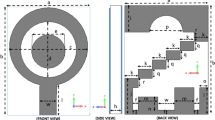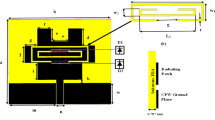Abstract
A simple reconfigurable printed antenna is reported in this paper. The structure comprises of two semicircular slots separated symmetrically by one thin metallic strip and two PIN diodes, and is excited by a U-shaped microstrip feed line. The PIN diodes are placed at both ends of the strip. The frequency tuning can be achieved in two different operating frequency bands within the C-band corresponding to the two different states of PIN diodes. This frequency-hopping property of the proposed radiator provides 21.88% and 26.3% (S11 < −10 dB and VSWR < 2) impedance bandwidths (IBW) during the ON and the OFF states of the PIN diodes, respectively. Moreover, the proposed design offers peak gain of about 4.2 and 2.5 dBi during the OFF and ON states of the diodes with low cross-polarization (XP) level in the two principal planes. The antenna provides broadside and monopole-like radiation patterns in the ON and OFF states of the PIN diodes, respectively. Ansys High-Frequency Structural Simulator (HFSS) version 16.2 (Ansys High-Frequency Structural Simulator (HFSS) Ver.16.2, [1]) has been used to carry out the simulations for the presented antenna. The proposed antenna has the potential to be used for wireless and space applications.
Access provided by Autonomous University of Puebla. Download conference paper PDF
Similar content being viewed by others
Keywords
- Frequency reconfigurable antenna
- Pattern diversity
- PIN diode switch
- Semicircular microstrip slot antenna
1 Introduction
Due to greater consumer demand for high-speed wireless communications, and the resulting increase in spectrum use, the use of reconfigurable antennas is being considered as one of methods for optimizing spectrum allocation. Reconfigurability in an antenna can be achieved by changing its operating frequency, radiation pattern, or polarization using different techniques like (i) electrical (by integrating electronic switching components), (ii) optical (by incorporating photoconductive switches), (iii) physical (by altering radiating structure of an antenna), and (iv) using smart materials (like ferrite, liquid crystal, etc.) [2]. Electrical switching techniques like the integration of some radio frequency micromechanical system (RF-MEMS) [3], varicap devices [4], and PIN diodes [5,6,7,8] in the antenna structure can easily be used to achieve reconfigurability. Such electrical switching components redistribute the surface current or alter the radiating structure/edges of the antennas to achieve reconfigurability [2]. With the advancement of planar microwave technology, compact printed antennas can be fabricated at low costs. Also, the integration of such electrical switching components is easier with the planar antenna [9]. So, considering the merits of printed and reconfigurable antennas, a frequency reconfigurable radiator is designed and reported in this paper. The parametric optimizations and the study of performance parameters have been done using HFSS, and some of the results are presented in the subsequent sections. Some past studies on reconfigurable semicircular/circular slot antennas are presented in Fig. 1.
2 Configuration
Figure 2 reveals the geometry of the radiator. There are two semicircular slots, separated symmetrically by a thin metallic rectangular strip. Two PIN diodes are incorporated into the structure and are placed at each end of the strip just between the edge of the rectangular strip and the edge of the circular slot. The antenna is excited by a U-shaped microstrip feed line supported by FR4 substrate (relative permittivity ε = 4.4) of dimensions 50 mm × 43 mm along “x” and “y” axes, respectively, and a thickness of t = 1.6 mm. The ground plane is located at the top of the FR4 substrate. First, a circular slot of radius 13.3 mm with center at the exact center of the substrate is etched out of the ground plane leaving a copper strip of dimensions 1 mm × 26.6 mm along the diameter. Two additional small squares of 1 mm × 1 mm are etched out at the ends of this thin metallic strip and PIN diodes are connected across them as shown in Fig. 2b. The structure in Fig. 2c shows the U-shaped feed. The PIN diodes perform switching function in the design. During the forward biased condition of PIN diodes, the switches are acting in ON state while in the reverse bias, the switches are in OFF state. The equivalent lumped circuit model of the diode in the two states (ON and OFF) is shown in Fig. 2d (inset top right) and the same has been used in simulation [9]. The inductor value is almost negligible in both states (0.09 nH) and does not affect the radiations significantly. The resistor values are 4.7 Ω for ON state and 2 kΩ for OFF state, respectively, with capacitance of 0.017 pF in OFF state [10]. The detailed parameters of the proposed structure are given below:
Ground Plane (GP): Length (L) = 50 mm, Width (W) = 43 mm; Radiator: Slot radius (R) = 13.3 mm, a = 1 mm, b = 1 mm; Feed: l1 = 6.7 mm, w1 = 3.2 mm, r1 = 1.8 mm, r2 = 5 mm, l2 = 12.9 mm, w2 = 1.66 mm.
3 Simulated Results
First, one circular slot antenna with radius R is designed and excited by a simple 50 Ω microstrip line as shown in Fig. 3 (inset left bottom corner). The return loss and radiation characteristics reveal the fact that with increment in R the return loss improves but the peak gain deteriorates. So, the radius R is chosen as 13 mm considering the trade-off. After that, the feed is modified to be U-shaped. The modification of the feed leads to an improvement in the impedance bandwidth and we get IBW of 106.5% (S11 < −10 dB). Next, a horizontal metallic strip is incorporated across the diameter (referred to as antenna I, Fig. 4.) and then two small rectangular boxes of dimension 1 mm × 1 mm × 0.035 mm were etched out at the ends of diameter (referred to as antenna II, Fig. 5.). The return loss characteristics shown in Figs. 4 and 5 reveals the fact that the semicircular slots operate over the frequency band 6–7.4 GHz, whereas the circular slot antenna with thin metal strip operates over the band 3.4–4.5 GHz. The three-dimensional (3D) radiation characteristics are also shown in Figs. 4 and 5 and indicates that at 6.6 GHz, it provides broadside radiation pattern with peak gain 4 dBi, whereas at 4 GHz, it offers monopole-like radiation characteristics with peak gain 2.7 dBi, respectively.
Now, one PIN diode each is connected at both ends of the strip keeping the benefit in mind that when the diodes are ON, the effective geometry is similar to antenna I shown in Fig. 4, but when the diodes are OFF, it is like antenna II in Fig. 5. The return loss characteristics of the proposed antenna shown in Fig. 6a also verify the fact that at ON and OFF states of PIN diodes, the antenna operates over 5.8–6.2 GHz and 3.4–4.4 GHz, respectively. The proposed antenna geometry is again fed by a simple microstrip line and it reveals the fact that the performance of the U-shaped feed is superior compared to the simple conventional feedline. Sometimes, the microstrip feed causes spurious radiation, but for a good design, the feedline should not radiate. To clarify this issue in present design, the return loss characteristic of only the feedline has been studied and the minimum S11 value is about −2.7 dB, which reveals the fact that the feed is not taking part in radiation. So, there is no spurious radiation from the feed. The 3D radiation pattern of the proposed antenna has been shown in Fig. 6b which indicates the pattern diversity of the antenna. The radiation pattern of the antenna in two principal planes at two different operating frequencies are shown in Fig. 7 and they indicate low cross-polarization levels.
The surface current densities of the proposed antenna during ON and OFF states are similar to the surface current densities of antenna I and antenna II, respectively, as shown in Fig. 8a, b. When the PIN diodes are ON, i.e., two similar semicircular slots are radiating. At resonant frequency 6.4 GHz, the current distribution of the lower semicircular slot is prominent and three half-wavelength variations along the perimeter of the semicircular slot are prominent. If λ is the wavelength corresponding to the frequency of S11 minimum, then n(=3) times of (λ/2) = perimeter of the semicircular slot = (π + 2) R. Similarly, when the diodes are OFF, i.e., circular slot with strip-line is radiating, at resonant frequency of 3.8 GHz, current distribution is mostly along the perimeter of the circular slot and it has two times of the half-wavelength variation. At resonant frequency 3.8 GHz, n(=2) times of (λ/2) = perimeter of the circular slot = 2πR. So, in the present design, the frequency reconfigurability is obtained by changing the current distribution as well as the antenna geometry by introducing PIN diode switching elements.
4 Conclusion
A simple low-profile, low-cost, and frequency reconfigurable antenna with diversified patterns in far-field is reported in this paper. The frequency tuning is achieved by integrating PIN diodes in the structure. To verify the results of the proposed active antenna in the two states, an equivalent passive antenna design analysis was carried out and was found to be in accordance. The biasing circuitry of pin diodes in the prototype plays a significant role in the performance of the antenna. So, in the future, before fabrication, further analysis on biasing circuitry will be carried out using some electromagnetic circuit designer tool. Also, many different methods for antenna miniaturization can be employed to make the antenna more compact like using a thicker substrate, introducing matching circuitry, and using artificial magnetic conductor (AMC) surface among others. One potential application of the proposed structure can be in RF front ends for wireless and space communication. Moreover, frequency hopping in the useful bands for WLAN and Wi-Fi applications is also achievable by changing the dimensions of the proposed radiator.
References
Ansys High Frequency Structural Simulator (HFSS) Ver.16.2
Christodoulou, C., Tawk, Y., Lane, S., Erwin, S.: Reconfigurable antennas for wireless and space applications. Proc. IEEE 100, 2250–2261 (2012)
Balcells, J., Damgaci, Y., Cetiner, B., Romeu, J., Jofre, L.: Polarization reconfigurable MEMS-CPW antenna for mm-wave applications. In: 2010 Proceedings of the Fourth European Conference on Antennas and Propagation (EuCAP), pp. 1–5. IEEE, Barcelona (2010)
Korošec, T., Ritoša, P., Vidmar, M.: Varactor-tuned microstrip-patch antenna with frequency and polarisation agility. Electron. Lett. 42, 1015 (2006)
Nikolaou, S., Ponchak, G., Papapolymerou, J., Tentzeris, M.: Design and development of an annular slot antenna (ASA) with a reconfigurable radiation pattern. In: 2005 Asia-Pacific Microwave Conference Proceedings (2005)
Sharma, S., Kumar, R., Vijay, R.: A frequency re-configurable semi-circular slot antenna for cognitive radio. In: 2015 1st International Conference on Next Generation Computing Technologies (NGCT) (2015)
Li, Y., Li, W., Yu, W., Wan, J.: A small multi-function circular slot antenna for reconfigurable UWB communication applications. In: 2014 IEEE Antennas and Propagation Society International Symposium (APSURSI) (2014)
Li, Y., Li, W., Ye, Q.: A CPW-fed circular wide-slot UWB antenna with wide tunable and flexible reconfigurable dual notch bands. Sci. World J. 2013, 1–10 (2013)
Bhartia, P., Bahl, I., Garg, R., Ittipiboon, A.: Microstrip antenna design handbook. Artech House, Boston (2001)
Garver, R.V.: Microwave diode control devices, Artech House Publication (1977)
Author information
Authors and Affiliations
Corresponding author
Editor information
Editors and Affiliations
Rights and permissions
Copyright information
© 2019 Springer Nature Singapore Pte Ltd.
About this paper
Cite this paper
Aakanksha, Dasgupta, B. (2019). A Simple Reconfigurable Printed Antenna for C-Band Applications. In: Ray, K., Sharan, S., Rawat, S., Jain, S., Srivastava, S., Bandyopadhyay, A. (eds) Engineering Vibration, Communication and Information Processing. Lecture Notes in Electrical Engineering, vol 478. Springer, Singapore. https://doi.org/10.1007/978-981-13-1642-5_40
Download citation
DOI: https://doi.org/10.1007/978-981-13-1642-5_40
Published:
Publisher Name: Springer, Singapore
Print ISBN: 978-981-13-1641-8
Online ISBN: 978-981-13-1642-5
eBook Packages: EngineeringEngineering (R0)












